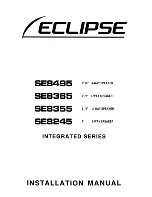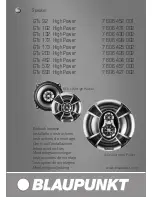
Once you have established that your chosen location is be-
tween two joists or trusses, and that there are no obstructions
in the ceiling, scribe a clear line around the inside edge of
the template with a pencil.
If the ceiling is made of drywall, simply cut the marked area
with your utility knife or drywall saw. If the ceiling is made of
plaster, use a saw with a higher tooth count to reduce the
risk of breaking the plaster. Test fit the speaker in the hole;
the speaker should fit loosely and the speaker frame should
cover the edges of the hole. Repeat these steps for the other
speaker.
5) Speaker
Cable
Don’t compromise sound quality by using thin, inexpensive
speaker wire, we recommend using a high quality oxygen free
copper speaker cable. For runs less than 50 feet we recom-
mend 16 gauge cable, and for longer runs we recommend 14
gauge or larger cable. Most municipalities require the use of
CL2 rated speaker cable for installation in walls and ceilings.
Leave enough speaker cable so you can stand comfortably
on the floor or ladder while connecting the speaker cable to
the speakers.
6) Speaker
Connection
Remove about 8" of the cable jacket to expose the inner
conductors. Strip 1/4" of insulation from each conductor and
connect to the speaker terminals. When connect-
ing the wires to the speakers, be sure to observe
proper polarity. Most CL2 rated speaker cable will
have red and black conductors, so you will connect
the red wire to the red speaker terminal and the
black wire to the black speaker terminal.
Note:
Your dual-channel ceiling speaker has two
pairs of terminals, and both pairs should be
used. Connect one amplifier channel to each
pair of terminals.
7) Final
Installation
To install the speakers into the ceiling,
remove the grills, this will give you access
to the mounting screws. Turn the mount-
ing clamps so they are positioned as in
the illustration, this will allow the speak-
ers to clear the hole for installation. Insert
the speaker into the hole, and tighten the
mounting screws. As you turn each screw,
the mounting clamps will rotate outward to
engage the ceiling material.
CAUTION: Do Not Over-Tighten the Clamps. Too much torque may snap off the lug and the
speaker will not seat securely. A snug fit is all that is necessary to assure proper performance.
8) Painting
Speakers
To paint the grill of your Micro-Edge speakers, remove the grill assembly (with plastic trim edge)
from the speaker, and apply paint to the grill using an airbrush, airless sprayer, or spray can.
Do
not try to paint the chassis and grill assembly together,
the grill should always be removed
and painted separately. Do not apply heavy coats of paint that might block the perforations in
the grill, and allow the paint to fully dry before re-installing the painted grill.






















